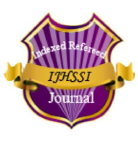International Journal of Humanities and Social Science Invention (IJHSSI)
Differential Analysis of Four Teaching-Learning Models Applying to Students with Autism Spectrum Disorder. International Journal of Humanities and Social Science Invention (IJHSSI), Volume 14 Issue 5 || May 2025 || PP. 164-171. ISSN (Online): 2319 – 7722, ISSN (Print): 2319 – 7714. www.ijhssi.org
https://www.ijhssi.org/vol14-issue5.html
https://www.ijhssi.org/papers/vol14(5)/1405164171.pdf
ABSTRACT
Conceptually, autism spectrum disorder is shaped a disability linked to neurodevelopmental developmental disorders, regarding to the information transmission through the functional system of gamma-aminobutyric acid or GABAergic system, which is observed throughout deficits in the communication area, social interaction and restrictive behaviours, as defined by the International Classification of Diseases (DSM-5) of the American Psychiatric Association (2013) (APA). This study analyzed the implementation of greater or lesser intensity in applying regarding four teaching-learning models will be able encourage the overall development of this diagnostic group. Results showed that educational models based on projects, through the higher intensity of cooperative learning among peers, combined with a partial support process, increased the cognitive and curricular development of this population, which, in fact, was observed in the critical levels of significance tested through Kruskal-Wallis Test analysis.
KEY WORDS:
Autism Spectrum Disorder, Educational Models, Deductive and Relational Abilities, Mechanical and Meaningful Memory.
REFERENCES
[1]. American Psychiatric Association (2013). Diagnostic and statistical manual of mental disorders (5th ed.). https://doi.org/10.1176/appi.books.9780890425596
[2]. Baghdadli, A., Michelon, C., Pernon, E., Picot, M. C., Miot, S., Sonié, S., Rattaz, C., & Mottron, L. (2018). Adaptive trajectories and early risk factors in the autism spectrum: A 15-year prospective study. Autism Research, 11(11), 1455–1467. https://pubmed.ncbi.nlm.nih.gov/30270526/
[3]. Best, J. R., Miller, P. H., & Naglieri, J. A. (2011). Relations between executive function and academic achievement from ages 5 to 17 in a large, representative national sample. Learning and Individual Differences, 21(4), 327–336. https://doi.org/10.1016/j.lindif.2011.01.007
[4]. Brown, M., Matson, J., Callahan, M., & Tevis, C. (2023). Examining the relationship between social functioning and daily living skills in children with and without Autism Spectrum Disorder. Journal of Developmental and Physical Disabilities, 35, 577–588. https://doi.org/10.1007/s10882-022-09865-6
[5]. Brown, W. H., & Conroy, M. A. (2011). Social-emotional competence in young children with developmental delays: Our reflection and vision for the future. Journal of Early Intervention, 33, 310–320. DOI:10.1177/1053815111429969
[6]. Cook, F., & Oliver, C. (2011). A review of defining and measuring sociability in children with intellectual disabilities. Research in Developmental Disabilities, 32(1), 11–24.
[7]. Craig, A. D. (2009). How do you feel–now? The anterior insula and human awareness. Nature Reviews Neuroscience, 10(1), 59–70. https ://doi.org/10.1038/nrn25 55
[8]. Diamond, A. (2013). Executive functions. Annual Review of Psychology, 64, 135–168. https://doi.org/10.1146/annur ev-psych -113011-14375 0
[9]. Franchini, M., Zöller, D., Gentaz, E., Glaser, B., de Wilde, W., Kojovic, H., & Schaer, N. M. (2018). Early adaptive functioning trajectories in preschoolers with autism spectrum disorders. Journal of Pediatric Psychology, 43(7), 800–813. https://pubmed.ncbi.nlm.nih.gov/29701857/
[10]. Gangopadhyay, I., McDonald, M., Ellis Weismer, S., & Kaushanskaya, M. (2018). Planning abilities in bilingual and monolingual children: Role of verbal mediation. Frontiers in Psychology, 9, 1–14. https://doi.org/10.3389/fpsyg .2018.00323
[11]. Green, S. A., Hernandez, L., Bookheimer, S. Y., & Dapretto, M. (2016). Salience network connectivity in autism is related to brain and behavioral markers of sensory overresponsivity. Journal of the American Academy of Child and Adolescent Psychiatry, 55(7), 618–626. e611. https://doi.org/10.1016/j.jaac.2016.04.013
[12]. Guralnick, M. J. (2010). Early intervention approaches to enhance the peer-related social competence of young children with developmental delays. Infants & Young Children, 23, 73–83. DOI:10.1097/iyc.0b013e3181d22e14
[13]. Hernandez, L. M., Rudie, J. D., Green, S. A., Bookheimer, S., & Dapretto, M. (2015). Neural signatures of Autism Spectrum Disorders: Insights into brain network dynamics. Neuropsychopharmacology, 40(1), 171–189. https://doi.org/10.1038/npp.2014.172
[14]. Hill, E. L. (2004). Executive dysfunction in autism. Trends in Cognitive Sciences, 8, 26–32. https://doi.org/10.1016/j.tics.2003.11.003
[15]. Holland, L., & Low, J. (2010). Do children with autism use innerspeech and visuospatial resources for the service of executive control? Evidence from suppression in dual tasks. British Journal of Developmental Psychology, 28(2), 369–391. https://doi.org/10.1348/02615 1009X 42408 8.
[16]. Kana, R. K., Libero, L. E., Hu, C. P., Deshpande, H. D., & Colburn, J. S. (2014). Functional brain networks and white matter underlying theory-of-mind in autism. Soc Cogn Affect Neurosci, 9(1), 98–105. https://doi.org/10.1093/scan/nss10 6
[17]. Koegel, L. K., Kuriakose, S., Singh, A. K., & Koegel, R. L. (2012). Improving generalization of peer socialization gains in inclusive school settings using initiations training. Behavior Modification, 36, 361–377. DOI:10.1177/0145445512445609
[18]. Krall, S. C., Rottschy, C., Oberwelland, E., Bzdok, D., Fox, P. T., Eickhoff, S. B., … & Konrad, K. (2015). The role of the right temporoparietal junction in attention and social interaction as revealed by ALE meta-analysis. Brain Struct Funct, 220(2), 587–604. https ://doi.org/10.1007/s0042 9-014-0803-z
[19]. Larson, C., Gangopadhyay, I., Prescott, K., Kaushanskaya, M., & Weismer, S. E. (2020). Planning in children with Autism Spectrum Disorder: the role of verbal mediation. Journal of Autism and Developmental Disorders, 51, 2200–2217. https://doi.org/10.1007/s10803-020-04639-5
[20]. Leung, R. C., & Zakzanis, K. K. (2014). Brief report: cognitive flexibility in Autism Spectrum Disorders: a quantitative review. Journal of Autism and Developmental Disorders, 44(10), 2628–2645. https://doi.org/10.1007/s1080 3-014-2136-4
[21]. Lord, C., Rutter, M., DiLavore, P. C., & Risi, S. (1999). Autism Diagnostic Observation Schedule-WPS (ADOS-WPS). Los Angeles, CA: Western Psychological Services. https://research.chop.edu/car-autism-roadmap/autism-diagnostic-observation-schedule-2nd-edition-ados-2
[22]. Maenner, M. J., Shaw, K. A., Bakian, A. V., Bilder, D. A., Durkin, M. S., Esler, A., & Cogswell, M. E. (2021). Prevalence and characteristics of Autism Spectrum Disorder among children aged 8 years- autism and developmental disabilities monitoring network, 11 sites, United States, 2018. MMWR Surveillance Summaries, 70(11), 1. https://pubmed.ncbi.nlm.nih.gov/34855725/
[23]. Martinez, J. R., Waters, Ch. L., Conroy, M. A., & Reichow, B. (2021). Peer-mediated interventions to address social competence needs of young children with ASD: systematic review of single-case research design studies. Topics in Early Childhood Special Education, 40(4), 217–228. DOI: 10.1177/0271121419839136. tecse.sagepub.com
[24]. Matson, J. L., Boisjoli, J. A., Hess, J., & Wilkins, J. (2010). Factor structure and diagnostic fidelity of the baby and Infant Screen for children with autism traits-part 1 (BISCUIT-Part 1). Developmental Neurorehabilitation, 13(2), 72–79. https://pubmed.ncbi.nlm.nih.gov/20222767/
[25]. Matson, J. L., Hess, J. A., Sipes, M., & Horovitz, M. (2010). Developmental profiles from the Battelle developmental inventory: A comparison of toddlers diagnosed with Down Syndrome, global developmental delay and premature birth. Developmental Neurorehabilitation, 13(4), 234–238. https://pubmed.ncbi.nlm.nih.gov/20629589/
[26]. Mitchell, S., Cardy, J. O., & Zwaigenbaum, L. (2011). Differentiating autism spectrum disorder from other developmental delays in the first two years of life. Developmental Disabilities Research Reviews, 17(2), 130–140. https://pubmed.ncbi.nlm.nih.gov/23362032/
[27]. Patriquin, M. A., DeRamus, T., Libero, L. E., Laird, A., & Kana, R. K. (2016). Neuroanatomical and neurofunctional markers of social cognition in Autism Spectrum Disorder. Human Brain Mapping, 37(11), 3957–3978. https://doi.org/10.1002/hbm.23288
[28]. Pellicano, E., Kenny, L., Brede, J., Klaric, E., Lichwa, H., & McMillin, R. (2017). Executive function predicts school readiness in autistic and typical preschool children. Cognitive Development, 43, 1–13. https://doi.org/10.1016/j.cogdev.2017.02.003
[29]. Shic, F., Bradshaw, J., Klin, A., Scassellati, B., & Chawarska, K. (2011). Limited activity monitoring in toddlers with Autism Spectrum Disorder. Brain Research, 1380, 246–254. https://pubmed.ncbi.nlm.nih.gov/21129365/
[30]. Singer, T. (2006). The neuronal basis and ontogeny of empathy and mind reading: Review of literature and implications for future research. Neuroscience and Biobehavioral Reviews, 30(6), 855–863. https://doi.org/10.1016/j.neubiorev.2006.06.011
[31]. Sparrow, S. S., Cicchetti, D. V., & Saulnier, C. A. (2016). Vineland Adaptive Behavior Scales (Vineland-3) (3rd ed.). San Antonio, TX: Pearson. https://link.springer.com/referenceworkentry/10.1007/978-3-319-57111-9_1602
[32]. Unterrainer, J. M., Rauh, R., Rahm, B., Hardt, J., Kaller, C. P., Klein, C., et al. (2016). Development of planning in children with highfunctioning autism spectrum disorders and/or attention deficit/hyperactivity disorder. Autism Research, 9(7), 739–751. https://doi.org/10.1002/aur.1574.
[33]. Ventola, P., Saulnier, C. A., Steinberg, E., Chawarska, K., & Klin, A. (2014). Early-emerging social adaptive skills in toddlers with Autism Spectrum Disorders: an item analysis. Journal of Autism and Developmental Disorders, 44(2), 283–293. https://pubmed.ncbi.nlm.nih.gov/21567256/
[34]. Vogan, V. M., Leung, R. C., Safar, K., Martinussen, R., Smith, M. L., & Taylor, M. J. (2018). Longitudinal examination of everyday executive functioning in children with ASD: Relations with social, emotional, and behavioral functioning over time. Frontiers in Psychology, 9, 1–11. https ://doi.org/10.3389/fpsyg .2018.01774
[35]. Wallace, G. L., Silvers, J. A., Martin, A., & Kenworthy, L. E. (2009). Brief report: Further evidence for inner speech deficits in Autism Spectrum Disorders. Journal of Autism and Developmental Disorders, 39(12), 1735–1739. https://doi.org/10.1007/s10803-009-0802-8
[36]. Weismer, S. E., Kaushanskaya, M., Larson, C., Mathee, J., & Bolt, D. (2018). Executive function skills in school-age children with Autism Spectrum Disorder: association with language abilities. Journal of Speech, Language, and Hearing Research, 61(11), 2641–2658. https://doi.org/10.1044/2018_JSLHR -L-RSAUT-18-0026
Whalon, K., Conroy, M., Martinez, J., & Werch, B. (2015). School-based peer-related social competence interventions for children with Autism Spectrum Disorder: a meta-analysis and descriptive review of single case research design studies. Journal of Autism and Developmental Disorders, 45, 1513–1531. DOI:10.1007/s10803-015-2373-1
[38]. Williams, D. M., Bowler, D. M., & Jarrold, C. (2012). Inner speech is used to mediate short-term memory, but not planning, among intellectually high-functioning adults with Autism Spectrum Disorder. Development and Psychopathology, 24(1), 225–239. https://doi.org/10.1017/S0954 57941 10007 94
[39]. Williams, D. M., Peng, C., & Wallace, G. L. (2016). Verbal thinking and inner speech use in Autism Spectrum Disorder. Neuropsychology Review, 26(4), 394–419. https://doi.org/10.1007/s11065-016-9328-y
[40]. Wylie, K. P., Tregellas, J. R., Bear, J., & Legget, K. T. (2020). Autism Spectrum Disorder symptoms are associated with connectivity between large‑scale neural networks and brain regions involved in social processing. Journal of Autism and Developmental Disorders, 50, 2765–2778. https://doi.org/10.1007/s10803-020-04383-w
[41]. Zhang, J., & Wheeler, J. J. (2011). A meta-analysis of peer-mediated interventions for young children with Autism Spectrum Disorders. Education and Training in Autism and Developmental Disabilities, 46, 62–77. https://www.researchgate.net/publication/265599002_A_meta-analysis_of_peer-mediated_interventions_for_young_children_with_autism_spectrum_disorders_J_Zhang_JJ_Wheeler_Education_and_Training_in_Autism_and_Developmental_Disabilities_46_1_62





















